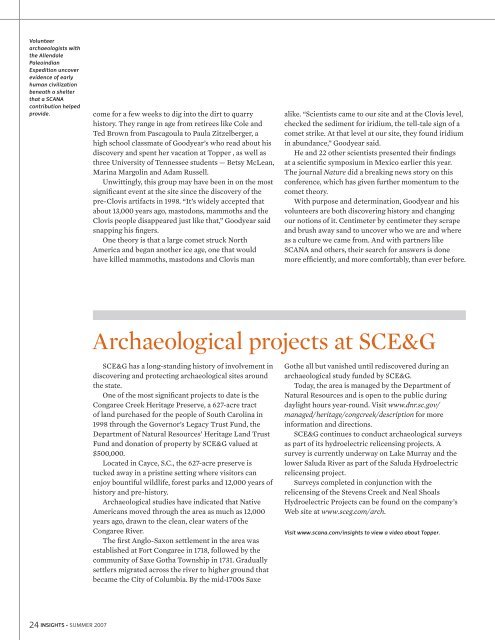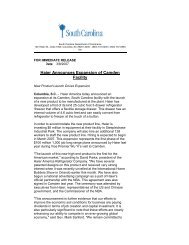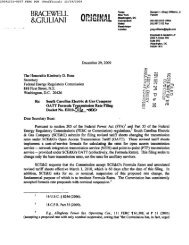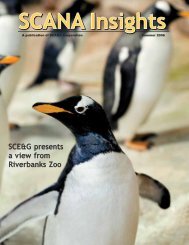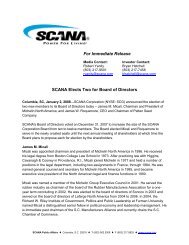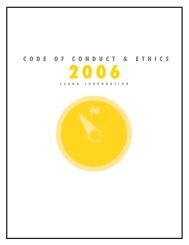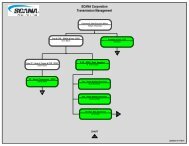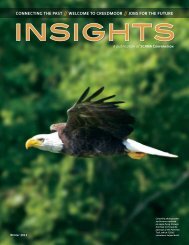Summer 2007 - SCANA Corporation
Summer 2007 - SCANA Corporation
Summer 2007 - SCANA Corporation
You also want an ePaper? Increase the reach of your titles
YUMPU automatically turns print PDFs into web optimized ePapers that Google loves.
Volunteer<br />
archaeologists with<br />
the Allendale<br />
Paleoindian<br />
Expedition uncover<br />
evidence of early<br />
human civilization<br />
beneath a shelter<br />
that a <strong>SCANA</strong><br />
contribution helped<br />
provide.<br />
come for a few weeks to dig into the dirt to quarry<br />
history. They range in age from retirees like Cole and<br />
Ted Brown from Pascagoula to Paula Zitzelberger, a<br />
high school classmate of Goodyear’s who read about his<br />
discovery and spent her vacation at Topper , as well as<br />
three University of Tennessee students — Betsy McLean,<br />
Marina Margolin and Adam Russell.<br />
Unwittingly, this group may have been in on the most<br />
significant event at the site since the discovery of the<br />
pre-Clovis artifacts in 1998. “It’s widely accepted that<br />
about 13,000 years ago, mastodons, mammoths and the<br />
Clovis people disappeared just like that,” Goodyear said<br />
snapping his fingers.<br />
One theory is that a large comet struck North<br />
America and began another ice age, one that would<br />
have killed mammoths, mastodons and Clovis man<br />
alike. “Scientists came to our site and at the Clovis level,<br />
checked the sediment for iridium, the tell-tale sign of a<br />
comet strike. At that level at our site, they found iridium<br />
in abundance,” Goodyear said.<br />
He and 22 other scientists presented their findings<br />
at a scientific symposium in Mexico earlier this year.<br />
The journal Nature did a breaking news story on this<br />
conference, which has given further momentum to the<br />
comet theory.<br />
With purpose and determination, Goodyear and his<br />
volunteers are both discovering history and changing<br />
our notions of it. Centimeter by centimeter they scrape<br />
and brush away sand to uncover who we are and where<br />
as a culture we came from. And with partners like<br />
<strong>SCANA</strong> and others, their search for answers is done<br />
more efficiently, and more comfortably, than ever before.<br />
Archaeological projects at SCE&G<br />
SCE&G has a long-standing history of involvement in<br />
discovering and protecting archaeological sites around<br />
the state.<br />
One of the most significant projects to date is the<br />
Congaree Creek Heritage Preserve, a 627-acre tract<br />
of land purchased for the people of South Carolina in<br />
1998 through the Governor’s Legacy Trust Fund, the<br />
Department of Natural Resources’ Heritage Land Trust<br />
Fund and donation of property by SCE&G valued at<br />
$500,000.<br />
Located in Cayce, S.C., the 627-acre preserve is<br />
tucked away in a pristine setting where visitors can<br />
enjoy bountiful wildlife, forest parks and 12,000 years of<br />
history and pre-history.<br />
Archaeological studies have indicated that Native<br />
Americans moved through the area as much as 12,000<br />
years ago, drawn to the clean, clear waters of the<br />
Congaree River.<br />
The first Anglo-Saxon settlement in the area was<br />
established at Fort Congaree in 1718, followed by the<br />
community of Saxe Gotha Township in 1731. Gradually<br />
settlers migrated across the river to higher ground that<br />
became the City of Columbia. By the mid-1700s Saxe<br />
Gothe all but vanished until rediscovered during an<br />
archaeological study funded by SCE&G.<br />
Today, the area is managed by the Department of<br />
Natural Resources and is open to the public during<br />
daylight hours year-round. Visit www.dnr.sc.gov/<br />
managed/heritage/congcreek/description for more<br />
information and directions.<br />
SCE&G continues to conduct archaeological surveys<br />
as part of its hydroelectric relicensing projects. A<br />
survey is currently underway on Lake Murray and the<br />
lower Saluda River as part of the Saluda Hydroelectric<br />
relicensing project.<br />
Surveys completed in conjunction with the<br />
relicensing of the Stevens Creek and Neal Shoals<br />
Hydroelectric Projects can be found on the company’s<br />
Web site at www.sceg.com/arch.<br />
Visit www.scana.com/insights to view a video about Topper.<br />
24 INSIGHTS • SUMMER <strong>2007</strong>


